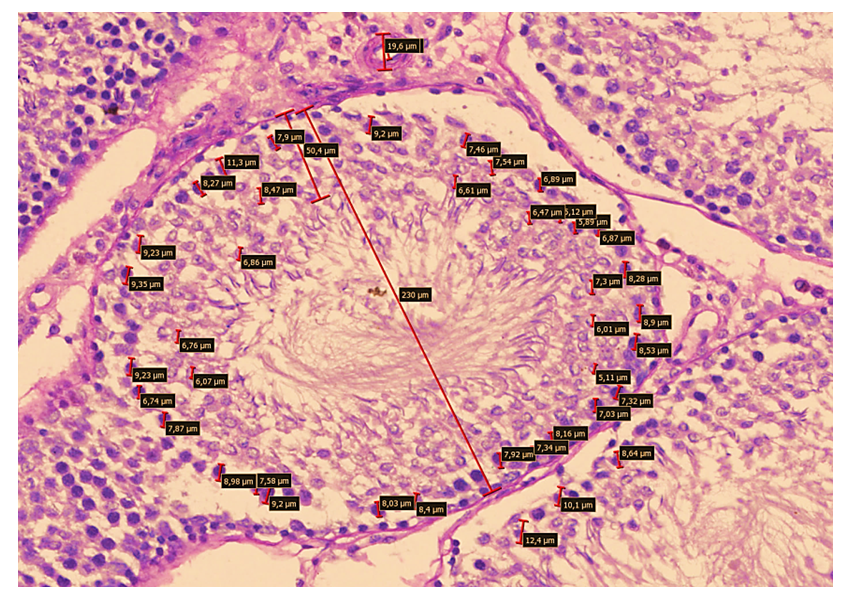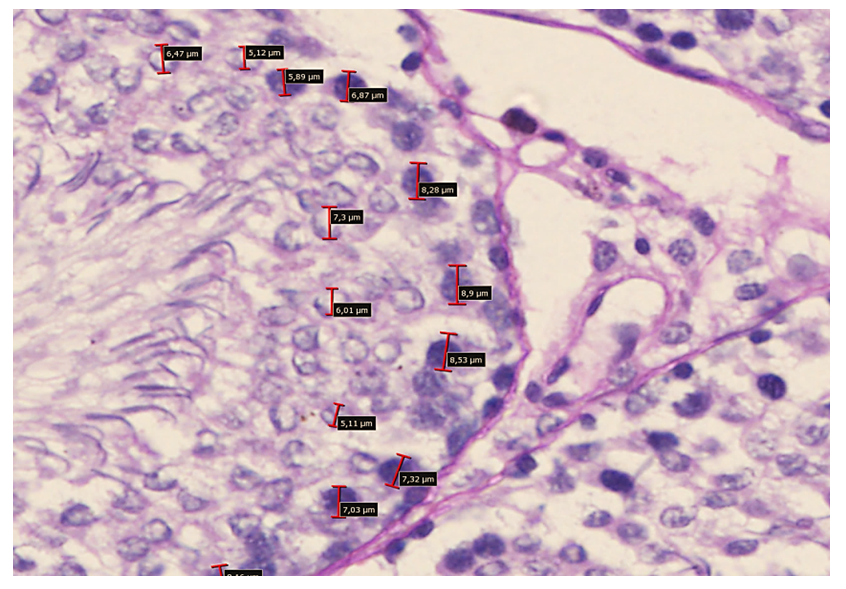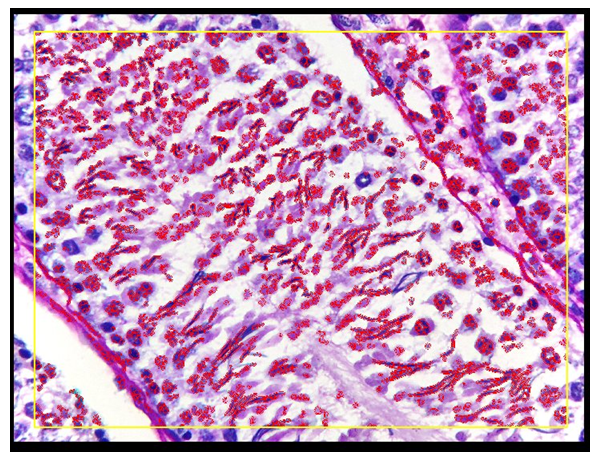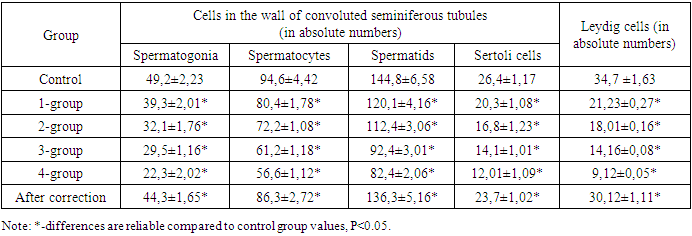-
Paper Information
- Next Paper
- Previous Paper
- Paper Submission
-
Journal Information
- About This Journal
- Editorial Board
- Current Issue
- Archive
- Author Guidelines
- Contact Us
American Journal of Medicine and Medical Sciences
p-ISSN: 2165-901X e-ISSN: 2165-9036
2023; 13(12): 1949-1952
doi:10.5923/j.ajmms.20231312.28
Received: Nov. 22, 2023; Accepted: Dec. 16, 2023; Published: Dec. 18, 2023

Morphometric Indicators of the Testis and Epididymis of Outbred Rats under Polypharmacy of Anti-Inflammatory Drugs and Correction with Pomegranate Seed Oil
Yodgorov I. F., Baymuradov R. R.
Bukhara State Medical Institute, Bukhara, Uzbekistan
Copyright © 2023 The Author(s). Published by Scientific & Academic Publishing.
This work is licensed under the Creative Commons Attribution International License (CC BY).
http://creativecommons.org/licenses/by/4.0/

This article presents morphometric data of the testes of white outbred rats under polypharmacy with drugs that have an anti-inflammatory effect and after correction with pomegranate seed oil. The composition of the spermatogenic epithelium in each experimental group is described. The percentage of different types of seminiferous tubules before and after correction was determined.
Keywords: Testes, Polypharmacy, Pomegranate seed oil
Cite this paper: Yodgorov I. F., Baymuradov R. R., Morphometric Indicators of the Testis and Epididymis of Outbred Rats under Polypharmacy of Anti-Inflammatory Drugs and Correction with Pomegranate Seed Oil, American Journal of Medicine and Medical Sciences, Vol. 13 No. 12, 2023, pp. 1949-1952. doi: 10.5923/j.ajmms.20231312.28.
1. Introduction
- Polypharmacy is when one or more medications are prescribed beyond clinical indications, resulting in adverse patient outcomes and failing to achieve the therapeutic goal. The scientists concluded that it should not be assumed that polypharmacy is always harmful and that clinical considerations on which medications were prescribed must be taken into account. However, the goal should be to ensure that patients receive only appropriate and targeted drug therapy to treat the disease [2].An adverse drug effect is an injury resulting from drug use. An adverse drug reaction is an adverse drug effect that refers to harm caused by a drug at normal dosages. Adverse drug effects are estimated to account for 5% to 28% of acute geriatric hospitalizations. Preventable adverse drug events are among the serious consequences of inappropriate medication use. Classes of drugs commonly associated with preventable adverse drug events include cardiovascular drugs, anticoagulants, hypoglycemic agents, diuretics, and NSAIDs [5].Each new drug prescribed increases the risk of side effects by 12-18% [1] and these iatrogenic accidents account for 5 to 25% of hospitalizations and 10% of emergency hospitalizations [3].In addition, polypharmacy has been shown to be a prognostic factor in terms of length of hospital stay, mortality and readmissions [4]. Based on the above, we can conclude that the harm of polypharmacy on internal organs has not been studied, and its correction is considered one of the main dilemmas of modern medicine.The purpose of the study: to study the effect of anti-inflammatory drugs and correction with pomegranate seed oil on the morphometric indicators of the testis and epididymis of rats in an experiment.
2. Research Methods
- The research was conducted in the scientific research laboratories of the Bukhara State Medical Institute and the Tashkent Medical Academy. In the experiment, the effect of several anti-inflammatory drugs and the result of correction were studied.3-month-old white male rats (n=300) kept in standard vivarium conditions were selected for the experiment. To study polypharmacy, rats were given the following drugs: paracetamol 94.1 mg/kg + aspirin 31.3 mg/kg + ibuprofen 37.6 mg/kg + dexamethasone 0.6 mg/kg + hydroxychloroquine sulfate 40.7 mg/kg.These drugs were administered intragastrically through a tube as a solution to each experimental group for 10 days. In last group, the experiment lasted relatively longer. That is, after the administration of drugs in the first 10 days, from the 11th to the 20th day, only pomegranate seed oil 10 mg/kg was administered for the purpose of correction. The control group received 0.5 ml of distilled water intragastrically instead of drugs.At the end of the experiment, the rats were euthanized under light ether (chloroform) anesthesia on an empty stomach. Testes were isolated, weighed, fixed in 10% neutral formalin, dehydrated in increasing concentrations of alcohol, and embedded in paraffin. Sections 5-7 μm thick were prepared on a microtome, deparaffinized in xylene, and stained with hematoxylin and eosin.NanoZoomer (REF C13140-21.S/N000198/HAMAMATSU PHOTONICS /431-3196 JAPAN) Hamamatsu (QuPath-0.4.0, NanoZoomer Digital Pathology Image) morphometric computer program were used for conducting morphometric examinations.The research materials were statistically processed.
3. Research Results and Conclusions
- Morphometric studies showed that the thickness of the membrane of testes of other experimental groups was not significantly different from that of experimental animals in the control group. However, when compared with the results of the control group, the number of convoluted seminiferous tubules, average diameter and volume of spermatogenic epithelia in the rats of the experimental group were lower to 26.8% compared to the control group, for example, 20.5% in the 1st group, 19.8% in the 2nd group, 17.6% in 3 groups and 16.3% in 4 groups, on the contrary, it was noted that the interstitial tissue area increased by 20.5% in all groups compared to the control group (Table 1).
 | Table 1. Morphometric parameters of testes of rats in control and experimental groups (M±m) |
|
 | Figure 1. Sizes of the convoluted tubule of control rats obtained from morphometric computer software |
 | Figure 2. Sizes obtained from the morphometric computer program of the convoluted tubes of rats of the experimental group in polypharmacy |
|
 | Figure 3. Graphical representation of the number of cells determined by morphometric computer software of testicular wall epithelial cells of rats treated with pomegranate seed oil after polypharmacy |
 Abstract
Abstract Reference
Reference Full-Text PDF
Full-Text PDF Full-text HTML
Full-text HTML
